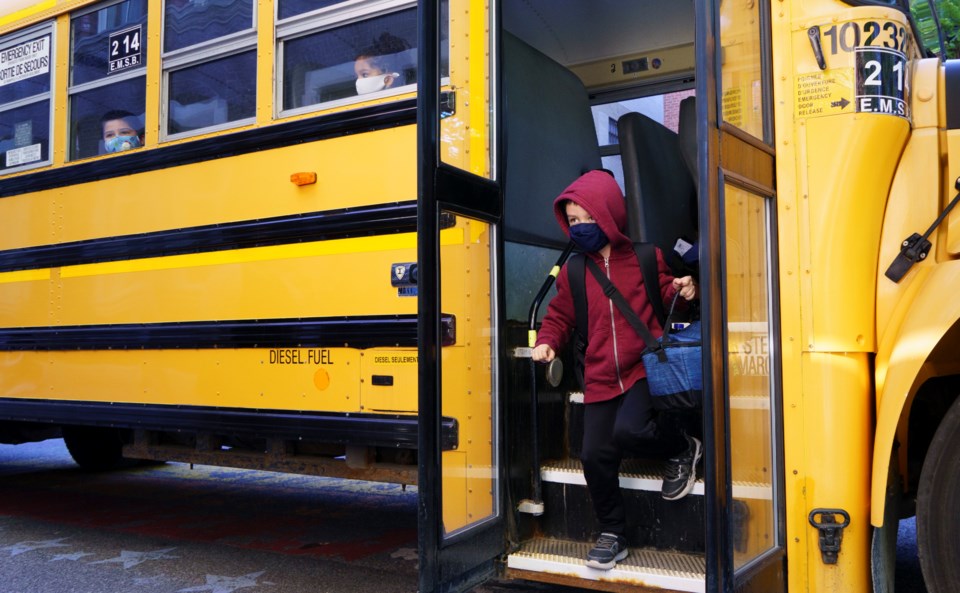An expert in pediatrics and infectious disease has advice for parents whose young children may be hesitant to wear face masks in school this fall.
Treat those face coverings like a cape or a shield — something a superhero might wear.
"Kids are more likely to take care of something if they have ownership of it, so if there's a way to personalize their mask — putting a logo on it, having it in their favourite colour — then do that," said Dr. Anna Banerji, an associate professor at the University of Toronto.
"It's like a cape, right? You say: 'this is something to protect you and you have to take care of it.'"
Provinces have different guidelines when it comes to students wearing face masks.
Ontario made face coverings mandatory for Grades 4 to 12 in indoor common areas, including classrooms, while Quebec's students in Grade 5 and up will wear them in all common areas except the classroom.
Alberta mandates masks for Grades 4 to 12 in areas such as hallways and on buses, and makes them optional for kids in kindergarten through Grade 3. B.C. students, meanwhile, are not required to wear masks, though the province says it will respect someone's personal choice to wear one.
Dr. Allison Carroll, a pediatric respirologist with the University of Alberta, says mask-wearing will be just one aspect of COVID prevention in a school setting, and hand hygiene becomes increasingly important for kids who will be constantly putting on or removing masks from their faces.
Teaching kids to wash their hands or use sanitizers before removing the mask is Step 1, she says. Hands also need to be washed or sanitized before putting a mask back on.
Having a clean, dry place to store a mask when not in use is also key.
Carroll recommends an envelope or paper bag that can be kept on the corner of the child's desk.
Tupperware containers or other non-breathable boxes are not advisable, she added. The same goes for attaching a face mask to a lanyard that can be worn around the neck.
"There is condensation that will accumulate on the mask while you're wearing it, so an enclosed space may potentially keep the mask damp," Carroll said. "And lanyards are not overly recommended because masks can become contaminated if they're hanging there and touching other surfaces."
Banerji says a lanyard, acting like a string that attaches a pair of mittens together, might be a solution if a kid is prone to losing things, however.
"It's better to have a mask than no mask," she said.
Misplaced masks can be solved by packing more than one. That will also help if one gets soiled during the day, Carroll said.
The experts suggest parents start teaching their children proper mask hygiene now so they're ready to wear them for long stretches of the school day.
Getting them used to the feeling of wearing a mask can be done gradually, Carroll says, starting by covering mouths only, before moving them up over their noses.
"Once they're comfortable with that you can get them to do activities like walking outside, doing some schoolwork at home, things they'll be doing in a school environment," she said.
Explaining why the new rules are in effect can help alleviate anxiety a child may have about wearing a mask, Banerji added.
"We have to reassure kids: 'masks are there to protect you. The new procedures are in place to protect you and your friends,'" she said. "If the parents are very anxious, that feeds into the kid's anxiety. So it's really important for parents to stay calm."
When it comes to the mask itself, experts say comfort, fit and breathability are important, noting that regular off-the-shelf masks at a store may be too big for a child's small face. Heavy fabrics should be avoided.
Masks with ear loops are recommended over ties for younger children who may not have the ability to handle knots on their own. Long strings can also be dangerous by posing risk of strangulation, Carroll says.
Parents can normalize mask-wearing as much as possible around their kids now, Carroll says, and that reinforcement should continue once school begins.
"Kids are amazingly adaptable and they model behaviour of friends and role models," she said. "So having positive attitudes from families and teachers is important, and hopefully they'll get positive attitudes from their peers too."
This report by The Canadian Press was first published Sept. 2, 2020.
Melissa Couto Zuber, The Canadian Press



